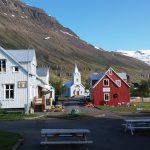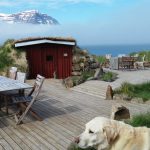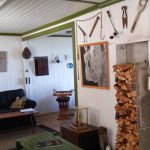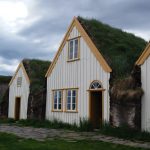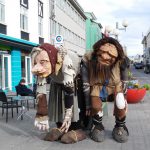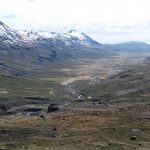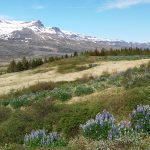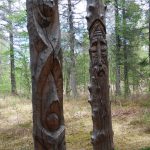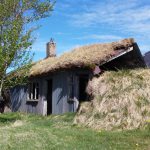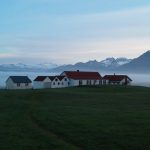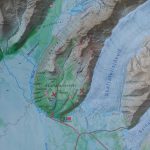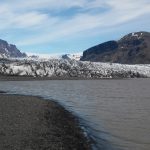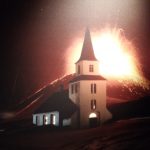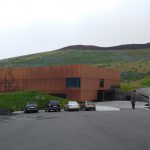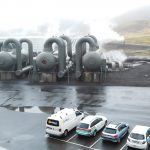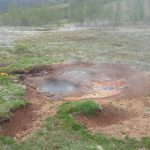Enst/Chem/Esci 254
Environmental Science in the Field
A Study of Ice and Fire: Iceland
Instructors: Kirsten Menking and Alison Spodek
Dear Field Course participants:
This is the eleventh Environmental Science in the Field travel course to be offered since the inception of the class in 1998. At this point, dozens of students have been involved in trips to the Pacific Northwest, the Bahamas, the American Southwest, Louisiana, Bermuda, Iceland, Germany, and Florida. Most of these excursions have been wonderful. However, we have had to deal with problem students on occasion. Some of the difficulties have arisen because of a student’s inability to cope with life in the field, though we have also had problems with student alcohol abuse and obnoxious, disruptive behavior. As a consequence, we have developed a series of readings to explain what expectations we have of students participating in this course, what expectations students can have for the experience, and what the accommodations will be like on our trip. The readings address living conditions, food, personal interactions, etc. and aim to head off problems before they arise by informing each of you fully about the trip. That way we will all have a great time!
Much of the text of these readings was originally written by Luther Brown, director of George Mason University’s field studies program, who himself has taken students to the Bahamas for over 30 years. We ask that you look over them thoroughly. If you think all the behavioral notes are overkill, just keep in mind that each one is inspired by real experiences (that is, headaches) that we, or our colleagues, have had, and that not all students behave as professionally as you do. If, after examining these readings, you feel that you will be unable to cope with the conditions described or that you will be unable or unwilling to meet the standards of conduct described, you should seriously consider whether it is worth applying for the trip.
Some General Notes About Iceland and Icelanders
We did our first field trip to Iceland in 2017. We had an absolutely wonderful time and are excited to travel there again with Vassar students! Here are a number of things that we learned about the country and its people.
- Landscape
Iceland is spectacularly beautiful and has been sculpted by the competing processes of volcanism and glaciation. Lying astride the mid-Atlantic ridge, the country belongs to two tectonic plates, the North American and Eurasian plates. It is also a geologic hotspot like Hawaii and the Galapagos islands. What this means is that volcanic eruptions are frequent, with the most recent one occurring this past summer (2023). Eruption of a different volcano in 2010 shut down European airspace for a couple of weeks as planes were grounded due to fears over ash-induced engine failures. We hope that we will be spared similar excitement on our trip! In any case, we will be seeing a lot of volcanic features, including lava flows, ash deposits, cinder cones, and geothermal areas.
At the same time that volcanism is actively building the land up, glaciers and the rivers that drain them are acting to tear it back down. Iceland is home to about a half a dozen ice caps, including the Vatnajökull, the largest ice cap in Europe at 8100 km2. Many of these ice caps crown active volcanoes whose geothermal heat melts the overlying ice and produces sub-glacial lakes. From time to time, massive outburst floods occur in which the water is released and inundates the lowlands. Massive sandur plains (expanses of braided river deposits) are produced by these floods, and Iceland’s national highway, the Hringveger (or Ring Road in English) has been subjected to repeated washouts from outburst events, causing logistical headaches.
The combined action of volcanism and glaciation means that Iceland is a land of nearly continual disturbance. Adding to these factors, Vikings moved to the island in ~871 A.D., bringing with them sheep. Forest cutting and grazing led to soil erosion that eventually caused the entire island to become deforested. Attempts to deal with the erosion began in the 1950s, and accelerated in the 1980s with a campaign to plant lupine as well as conifer and birch forests. Many of the plantings are non-native, and lupine has become particularly invasive. While many of the trees that were planted have been growing for a couple of decades, other areas have been planted only recently. The joke that “if you are lost in a forest in Iceland, you merely need to stand up,” is very much true as most trees are not much over chest high.
- Icelanders
Having to deal with the difficult geologic hand they’ve been dealt, not to mention long periods of darkness every winter arising from the island’s location near the Arctic Circle, Icelanders are a hardy people. Their population measures a mere ~375,000, most of whom are descended from Norse (Viking) men and Celtic women. Repeated volcanic eruptions and floods that killed off the sheep or led to crop failures caused frequent famines prior to modern times that also killed off many of the people. As a result, Icelanders display little genetic variability, a quality that has been exploited by companies seeking to understand the origin of genetically based disorders. A large proportion of the population has now contributed a cheek swab of their DNA in the service of helping us learn more about Alzheimer’s and other diseases.
As a population, Icelanders are quite friendly and happy to chat with tourists. When born, they are given last names based on the first names of their fathers. Females carry the suffix -dottir and males the suffix -son. The children of a man named Petur would therefore carry the surnames Petursson or Petursdottir depending on biological sex. Given a relatively small number of surnames and the confusion of having people in the same family with different last names, everyone goes by their first names. Informality is therefore the rule, and it is considered unnecessary to address someone as Ms. Olafsdottir or Mr. Jonsson rather than by the first name, even on the first meeting.
Despite the informality and the warm and open nature of Icelanders, they are also fastidiously tidy and very respectful of others. We hardly ever saw a piece of litter, whether in the capital city or along the roads in the countryside. In addition, it is standard practice to remove one’s shoes when entering a private home or hostel and sometimes even an office to cut down on tracking dirt into the space. Shoe racks lie adjacent to every front door. Icelanders are also very tidy when it comes to using the communal hot tub or sauna and expect everyone to have bathed prior to entering.
Like anywhere, Icelanders like to have a good time, and clubs in Reykjavík stay open until the wee hours of the morning. Amazingly, however, loud, boorish, drunken behavior does not occur, and hostels are totally quiet by 11 p.m. We were shocked by the behavior of 53 middle-school students on a class trip who shared a hostel with us out in the countryside. We were expecting not to get any sleep that night given our experience with typical American middle-schoolers. What we witnessed instead was everyone having a nice time, eating dinner and playing games, and then everyone taking showers and going to bed by 10:30. We did not hear a peep out of these kids the rest of the night! The same thing was true in Reykjavík. We could hear people coming home from the bars at 3 a.m. due to a heavy door in our hostel opening and closing, but except for this noise, no one made a sound. We mention this because Americans have a reputation abroad for being very loud and obnoxious. We expect you to take your behavioral cues from the surrounding culture and treat Icelanders with the same respect with which they are treating you.
Another amazing quality of Icelanders is their impeccable English, which they may speak even better than you do in some cases! We encountered only a few people who had a little bit of trouble, mostly out in the countryside, and even then, it was pretty easy to make ourselves understood. The ubiquity of English makes traveling around the country incredibly easy though also embarrassing as we have a challenging time pronouncing their words and place names. A pronunciation guide for special Icelandic letters will be made available during class.
- Economy
Being a small population on an island located in the far north Atlantic, Icelanders lived a pretty subsistence lifestyle until fairly recently. Life revolved around farming, particularly livestock farming of sheep for meat and wool. Fishing assumed a greater role with the advent of motorized boating in the early 1900s. Development of hydropower and geothermal energy resources allowed the construction of canneries and freezing plants that fostered active exports of fish. Amazingly, Iceland’s tiny population today places in the top 5 nations in the world for fish and fish product exports.
Heavy industry moved into Iceland in the 1970s. Taking advantage of the nation’s abundant energy resources, companies like Alcoa and Rio Tinto Alcan began shipping bauxite ore mined elsewhere to the country to be smelted into aluminum. When Iceland’s economy collapsed during the global economic downturn that began in 2008, aluminum exports gained still more prominence as a potential way to regain economic health. In addition, other nations began to eye Iceland as a potential partner in meeting their sustainable energy goals. Scotland, for example, would like Iceland to ship hydroelectricity to the UK via an undersea cable so that it can achieve renewable energy targets it has committed to under international agreements. Concerned about politicians and developers with dollar signs in their eyes, environmental groups have sprung up to prevent further hydroelectric dam construction in the interior highlands. These groups point out that the human population of Iceland currently uses only 20% of the electricity produced on the island, with 80% going to industry. They oppose further industrial development and point to the burgeoning tourism industry as a better way of growing Iceland’s economy. They are seeking to create a national park to protect the highlands from development, and we hope to meet with the head of one of these organizations while we’re in Reykjavík.
Speaking of tourism, an aggressive marketing campaign conducted by IcelandAir to promote the island as a stopover destination between North America and Europe has caused the number of visitors to explode in recent years. In the summer of 2022, the island received an influx of 1.7 million tourists. According to the Icelanders with whom we conversed, this economic boom has eliminated the nation’s foreign debt and allowed it to begin generating a governmental surplus in 2017. Our contacts noted that national polls demonstrate that Icelanders generally favor the expanded tourist trade given the job opportunities it has provided, though they also acknowledged that managing a tourist population that is 5 times as large as their own population is challenging. Some ecologically sensitive areas are being overrun, necessitating infrastructure improvements, for example to keep tourists confined to designated paths. Inasmuch as we will be tourists in Iceland ourselves, we hope to be able to give back to the island by participating in a project to plant native trees.
Living in Iceland
- Accommodations
We will be spending 3-4 nights at the Skálanes field station in eastern Iceland as well as hostels and hotels at various locations along Iceland’s southern coast and in Reykjavík. In these locations you will be sharing rooms with one another and possibly with other groups depending on the hostel configuration. You may occasionally be asked to share a double or queen sized bed with another person. If this bothers you, we would suggest packing a sleeping pad for camping.
Everywhere we go, we will be sharing bathrooms. Please keep this in mind and plan to be efficient. Bring a small bag that you can keep your toiletries in so that you don’t use up communal counter space by putting your stuff everywhere. Many hostels do not provide washcloths, shampoo, or soap, so plan to bring your own along. If you’re squeamish about sharing showers, you might want to pack a pair of flipflops. As we noted earlier, most hostels request that you check your shoes at the door, so you might want to bring along a thick pair of socks or slippers as well. Though we will be visiting Iceland in late spring, temperatures can be chilly in the evening and you might be happy to have something relatively warm on your feet. On the other hand, some hostels have radiant floor heating, making use of the abundant geothermal water, so having thin socks can also be nice.
As with many European nations, Icelanders don’t use top sheets on their beds. Instead, they have down comforters slipped inside of duvet covers. If you are a warm sleeper, this can become quite toasty even when you’re wearing summer PJs. You may desire to bring along a top sheet and/or a fleece blanket to use instead of the down comforter.
Sleeping in Iceland at the time of year we’re going to be visiting can be very challenging due to the nearly continuous daylight. We will be at 64 °N latitude, which is just 220 km south of the Arctic circle, the latitude above which there is 24 hours of daylight around the time of the summer solstice. Surprising to us, Icelanders do not put blackout shades or curtains on their windows, so if you’re light-sensitive like your instructors, you must bring your own eye mask or you will not be able to sleep. The sky never really gets all that dark, and the sun will be blazing in the window at 3 a.m., so be prepared. Though the midnight sun means that you may never experience the natural drowsiness that you feel here in New York, it’s important to make yourself try to sleep anyway in order to rejuvenate your body for the next day’s fieldwork. Along with your eye shade, you may want to bring ear plugs because you’ll likely be sleeping alongside people who snore or talk in their sleep.
- Water
The tap water in Iceland is of two varieties, hot and sulfurous or cold and very clean. When you are taking a warm shower or washing your hands with warm water, you will often feel like you are in Yellowstone national park, smelling fumaroles and boiling mud pots! The cold water is totally devoid of sulfur and tastes great. When filling your water bottle, make sure the hot water is turned off and run the cold tap until the hot water is out of the pipes.
- Laundry
Laundry is not something that field workers normally worry about. We’re in the field to do work, not look good, and we personally know many field workers who claim they like the feeling of getting really grungy for a couple of weeks and then coming home to freshen up. Be that as it may, there are laundry facilities at some hostels should you need them.
- WiFi
Almost everywhere has WiFi in Iceland, which is great for communicating with folks back home. We want to remind you that we’re on a study trip, however, and that part of your experience is to interact with other members of the group, the locals, and the landscape. If we discover that you’re constantly texting home instead of participating, we will not be pleased, and this will be reflected in your participation grade. We expect you to look out the window while we’re driving in order to take in the spectacular scenery, and not to have your head buried in your phone. Please confine your phone use to taking photos and to dealing with emails or texts for a short period before bed at night.
- Electricity
To recharge your phone, camera, and any other devices you will need to bring along an electrical adapter/converter. Iceland uses the European standard for power, which is 220 V (compared to 110 in the U.S.) and an outlet that accepts two circular prongs. Some of your devices may allow for variable voltage whereas others may require a transformer to convert from 220 to 110 V. All-in-one adapter/transformer units can be purchased at Best Buy in Poughkeepsie if you don’t already have one of these.
Some Comments on Field Trips and Food
It may seem intuitively obvious, but it’s worth repeating that field trips are done in the field. People who haven’t done field work before may not understand that working in remote places on a very limited budget means that you do not have the choices you might enjoy if you were on a cruise, in a hotel, or at home. You will be provided with as diverse a set of food choices as possible, but for some of the trip we will not have foods individually cooked to order, rather will eat from choices prepared for us at a field station. Even when we are at hostels, we will be cooking food as a group.
We have two basic rules about food on this trip: (1) food is fuel for working, so eat what you can when you can, and don’t be picky—we need you to be energetic; (2) food is a cultural experience, so do your best to enjoy local eating standards, or at least to learn from them if you don’t like them. We take the time to emphasize this for two reasons. The first is that everybody who does field work knows that there are two words involved in this phrase, and the second one is work. We don’t treat our excursion as a vacation, though it’s certainly fun, not to mention rewarding. Likewise, we don’t demand the kind of foods we would eat at home, because we know that demand could never be fulfilled and would be a waste of time. Indeed, most people who work in the field want to eat whatever is locally eaten, because that’s part of the experience itself and allows successful field workers to learn as much as possible during their trip.
We stress these points because food can be a sensitive subject, and we sometimes get trip participants who do not understand that the whole world doesn’t eat like they do personally or who demand to be catered to individually. While vegetarians are typically happy on these trips, it is virtually impossible to accommodate people who refuse any animal product (i.e., no dairy, no eggs, no honey), unless they are content with a very redundant diet. If you are one of these folks, then you should seriously consider bringing your own food supply with you, and you should definitely discuss your diet with one of us. The hostels we’ll be staying in typically have kitchens where you can cook for yourself, but the grocery shopping nearby may be less than you might desire.
If you have been put on a restricted diet for health/medical reasons, we will do the best we can to accommodate you. Please let us know as soon as possible what your restrictions are so that we can make the Skálanes staff aware of your needs. It may also be necessary for you to bring some of your own food supply.
As far as Icelandic cuisine goes, at breakfast you will generally be provided with a bunch of different types of bread (whole grain rye, rolls, rye-krisp), slices of cheese, cucumber, and tomatoes, a variety of meats, including lamb and fish, skyr (Icelandic yogurt), several types of jam/preserves, hardboiled eggs, and sometimes, different cereals and milk. Lunch and dinner generally also feature lamb and fish, which may be a bit distressing to vegetarians and vegans. Kirsten, who has been a vegetarian on animal rights grounds for ~40 years, was a little sad to see happy lambs cavorting in the countryside everywhere and then to see them on dinner plates in restaurants! Still, as a good field scientist, she accepted that the rest of the world does not eat the way she does and uncomplainingly found other things to eat, like salad.
When we are not at Skálanes or in a hostel, we will eat in restaurants. As with the rest of the cost of the trip, we will be paying for you. For this reason, we ask you to exercise some restraint and not order the most expensive thing on the menu at every meal. On the other hand, we don’t want you to starve yourself either, but we want you to know that Iceland is extremely expensive. We bought a loaf of bread, small block of cheese, tub of hummus, a single container of yogurt, and a muffin at a bakery in Reykjavík, and the cost was nearly $30!
Qualities Required of Successful Field Scientists
Field excursions require their participants to exhibit a number of personal qualities in order to be successful. One or two folks who don’t possess these qualities can turn a wonderful trip into a total drag. Here are the things you need to know:
- Field science requires teamwork. We will work together very closely virtually all day long, often until well after dinner, and sometimes until 10-11 p.m. We will not always be doing the same thing, and sometimes may be divided into subgroups that do different things, but the projects are all part of the same picture, and we will co-operate as a team. The team will occasionally include other staff, like the Skálanes field station manager and his employees and people from environmental organizations in Reykjavík. We expect you to treat all of your co-workers, both Vassarions and Icelanders, with courtesy and respect.
- This is not a vacation. Field scientists are almost always working on a very restricted budget. They are not on vacation, and usually live under spartan conditions in extremely beautiful, or at least interesting, surroundings. This is exactly our case. As described earlier, we will live at a field station in eastern Iceland and at hostels or small hotels everywhere else. In some cases, we will be in dormitory style housing, with two or more students sharing a single room. Students may on occasion have to share a double or queen size bed, and we will all be sharing bathrooms. At the Skálanes field station, we will assist with making meals, and while there will be some choices, we will have little control over the type of food served or any other aspect of daily services. When we are cooking for ourselves in hostels, we will be limited by what the local grocery store offerings are.
Because this is a study trip and not a vacation, we will not be sleeping in. Indeed, most days we’ll be out the door by 8 a.m. in order to maximize our fieldwork time. Please bring an alarm clock or put an alarm app on your cell phone.
- Tidiness is a virtue. We suspect that some of you are used to having other people clean up after you, and others probably just don’t care about mess and ignore it altogether. Neither of these attitudes is suitable for fieldwork. We want everyone to have the attitude that they are staying as a guest in someone’s house. If you clean up your own mess, everyone will be much happier.
- There will be little opportunity to shop for most of the trip. Fieldwork is done primarily in areas where the natural world can be observed. Often, these areas are remote and undeveloped. There are no shops to speak of in many of the places we are going. You may not be able to buy everything you desire, so if you anticipate needing something on the trip, bring it with you.
The lack of shopping opportunities means you also need to keep track of your personal gear. We will not have time to retrace our steps to pick up forgotten cell phones, toothbrushes, etc., so please keep track of your belongings and make sure you’ve got everything packed up before we head to the next location.
- We will work outdoors all day every day. We will be traveling in the late spring to early summer and will probably have rain. Winds may be chilly. The sun will burn for many more hours than in NY, so even if you feel cold you should take care to protect yourself from sunburn. Layers are the best way to dress and rain gear (both rain coat and pants) is a must.
Fieldwork in Iceland can present some special challenges for women and trans-men because the lack of trees means there aren’t too many places to hide behind when needing to go pee. Keep this in mind and avail yourself of every bathroom stop that comes along. Also, think carefully about your beverage choices and avoid drinking diuretic drinks like coffee all day long.
- Fieldwork requires flexibility. It goes without saying that fieldwork doesn’t always work out exactly as we might hope or expect. Field equipment breaks, vehicles get flat tires, and weather can take a turn for the awful. It is important to be flexible, to be able to deal with ambiguity, and to practice your Zen calm when circumstances are beyond your control.
- How does all of this affect you? Successful expeditions require that every participant be “with the team.” This means that you must recognize your fellows and respect them. Griping, complaining, moaning, etc. become disruptive very quickly. Slacking responsibilities or otherwise letting down the team will not be tolerated. Furthermore, you should consider the following non-academic requirements that are a consequence of the special nature of this course:
- Ability to cope with others. Practice being tolerant. You absolutely must be able to get along with your fellows. Friction among roommates, with the staff, or with your classmates will disrupt the course. If you are particularly messy at home, practice being organized, because you’ll have to act that way during the trip. If you are particularly organized at home, get ready for a week of disorganization, because that’s probably the way your roommates will be.
- Ability to cope with daily life. Participation in this class requires that you live with the group at a field station and in hostels. Vassar has no control over these facilities. Like most field stations around the world, the people doing the cooking are the most important staff, and run things however they want. We cannot plan menus, and will do our best to help you accommodate special diets, but make no promises. Professional field scientists learn very quickly to eat what’s available. If you are diabetic and need meals to be punctual, bring some munchies to tie you over. If you are on a restricted diet for medical reasons (e.g. food allergies, intolerances), let us know that ASAP so that we can make Skálanes aware in advance. Vegetarian food will be available at all times, but we cannot promise that vegan food will be.
- Ability to cope with the outdoors. You’ll encounter sun, rain, possibly intense winds, and uneven terrain for walking. Don’t fret about these things, but be sensible and safe. Also keep your energy up. Your activity will be threatened if you do not eat an adequate diet, and if you allow yourself to become dehydrated or sunburned. You may not need to eat breakfast at home, but you probably don’t do physical labor for 3-4 hours before lunch at home either. Obey all safety instructions we give you. Avoid injury, as it will be a long ride to the nearest hospital in many cases.
Iceland has very little in the way of safety infrastructure to protect tourists from their own stupidity. The cliffs surrounding the most popular waterfall in the country are not covered in guard-rails as they would be in the U.S. Rather, there’s a very thin rope warning tourists from getting any closer and signs that say that Icelanders expect you to exercise your own good judgment to avoid getting injured. The same is true at hot springs. Be safe and avoid horsing around.
- Why should you care? We hope you care because you want this trip to be as big a success as we do. Just in case, here are two more good reasons: 1. A portion of your grade is based on our evaluation of your ability to perform as a field scientist, using the criteria given above. 2. Should it become obvious to us that you are incapable of performing satisfactorily to the point of disrupting the class as a whole or threatening your own or the class’s safety, we will place you on a plane and send you back to New York at your own expense.


